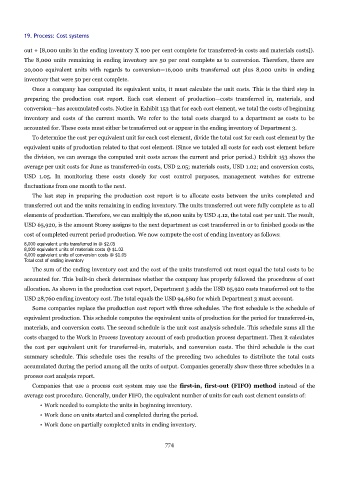Page 773 - Accounting Principles (A Business Perspective)
P. 773
19. Process: Cost systems
out + [8,000 units in the ending inventory X 100 per cent complete for transferred-in costs and materials costs]).
The 8,000 units remaining in ending inventory are 50 per cent complete as to conversion. Therefore, there are
20,000 equivalent units with regards to conversion—16,000 units transferred out plus 8,000 units in ending
inventory that were 50 per cent complete.
Once a company has computed its equivalent units, it must calculate the unit costs. This is the third step in
preparing the production cost report. Each cost element of production—costs transferred in, materials, and
conversion—has accumulated costs. Notice in Exhibit 153 that for each cost element, we total the costs of beginning
inventory and costs of the current month. We refer to the total costs charged to a department as costs to be
accounted for. These costs must either be transferred out or appear in the ending inventory of Department 3.
To determine the cost per equivalent unit for each cost element, divide the total cost for each cost element by the
equivalent units of production related to that cost element. (Since we totaled all costs for each cost element before
the division, we can average the computed unit costs across the current and prior period.) Exhibit 153 shows the
average per unit costs for June as transferred-in costs, USD 2.05; materials costs, USD 1.02; and conversion costs,
USD 1.05. In monitoring these costs closely for cost control purposes, management watches for extreme
fluctuations from one month to the next.
The last step in preparing the production cost report is to allocate costs between the units completed and
transferred out and the units remaining in ending inventory. The units transferred out were fully complete as to all
elements of production. Therefore, we can multiply the 16,000 units by USD 4.12, the total cost per unit. The result,
USD 65,920, is the amount Storey assigns to the next department as cost transferred in or to finished goods as the
cost of completed current period production. We now compute the cost of ending inventory as follows:
8,000 equivalent units transferred in @ $2.05
8,000 equivalent units of materials costs @ $1.02
4,000 equivalent units of conversion costs @ $1.05
Total cost of ending inventory
The sum of the ending inventory cost and the cost of the units transferred out must equal the total costs to be
accounted for. This built-in check determines whether the company has properly followed the procedures of cost
allocation. As shown in the production cost report, Department 3 adds the USD 65,920 costs transferred out to the
USD 28,760 ending inventory cost. The total equals the USD 94,680 for which Department 3 must account.
Some companies replace the production cost report with three schedules. The first schedule is the schedule of
equivalent production. This schedule computes the equivalent units of production for the period for transferred-in,
materials, and conversion costs. The second schedule is the unit cost analysis schedule. This schedule sums all the
costs charged to the Work in Process Inventory account of each production process department. Then it calculates
the cost per equivalent unit for transferred-in, materials, and conversion costs. The third schedule is the cost
summary schedule. This schedule uses the results of the preceding two schedules to distribute the total costs
accumulated during the period among all the units of output. Companies generally show these three schedules in a
process cost analysis report.
Companies that use a process cost system may use the first-in, first-out (FIFO) method instead of the
average cost procedure. Generally, under FIFO, the equivalent number of units for each cost element consists of:
• Work needed to complete the units in beginning inventory.
• Work done on units started and completed during the period.
• Work done on partially completed units in ending inventory.
774

